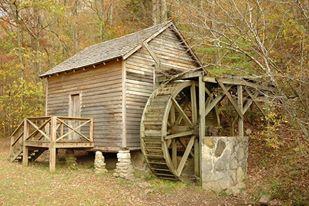The history of the Norton Grist Mill
The term “mill” has several meanings. In regards to the historic site at Big Ridge State Park called the Norton Grist Mill, it was used for grinding dry corn kernels into cornmeal.
The idea behind this type of mill was to use the energy of a stream’s running water to power the mill. Inside of the mill, the power was used to turn a large flat stone on top of another stone to grind the corn. Some mills used their energy for other tasks like sawing lumber, blowing air into a furnace of a foundry, or pumping water uphill.
Some mills were powered by wind instead of water. Many larger mills had a power take-off that could power many different tasks by changing a belt from one tool to another.
The Norton Grist Mill was used only for milling corn. Making cornmeal from your crop of corn was the means of survival for the settlers living in this area before the times of electricity.
This corn, along with canned foods, was used for many staples of the early American diet. Foods like grits and cornbread were used to nourish families for many generations.
Since most all farmers of the time needed to exchange dried corn for cornmeal, this time spent at the mill became a social time for the folks of each community. Folks would sit around and trade pocket knives and talk about how their crops fared for the year.
The Norton Grist Mill is a replica originally built by the CCC with some of the parts of the original mill. It had to be moved from its original location so that it was not lost by the creation of Norris lake.
The CCC understood the importance of saving our cultural history. The Norton Grist Mill is not the only mill that was preserved for historic reference. The Rice Mill that is now at Norris Dam State Park is also a preserved relic from our past. The Rice Mill was originally located in Lost Creek and was moved below Norris Dam by the CCC during the dam construction.
Many mills were scattered across the hills and hollers. Every community would usually have at least a grist mill for milling corn.
The Rice Mill in Lost Creek was also used as a blacksmith shop for a feller named Rufus Rice who used the blacksmith shop to build flintlock rifles. His rifles were made with beautiful detail and became an important tool for every household. If the build of these rifles is interesting to you then a visit to the Museum of Appalachia would be a great thing to do. Some of Rufus’s rifle making equipment is on display there.
Another mill was just outside of the town of Loyston, now flooded by Norris Lake. This mill was specifically used to blow air into an iron foundry. Iron ore is a rock that had iron throughout.
The foundry was a furnace that would blow air from the power of the mill to create a very hot fire that would separate the iron from rocks and create a metal that was called wrought iron. Some evidence of the mines used to collect the iron ore needed for the iron furnace are still evident on top of Big Ridge. This metal was used for lots of things like wagon parts, door/gate hinges, guns, and many other things important to early American survival and success.
- Log in to post comments
